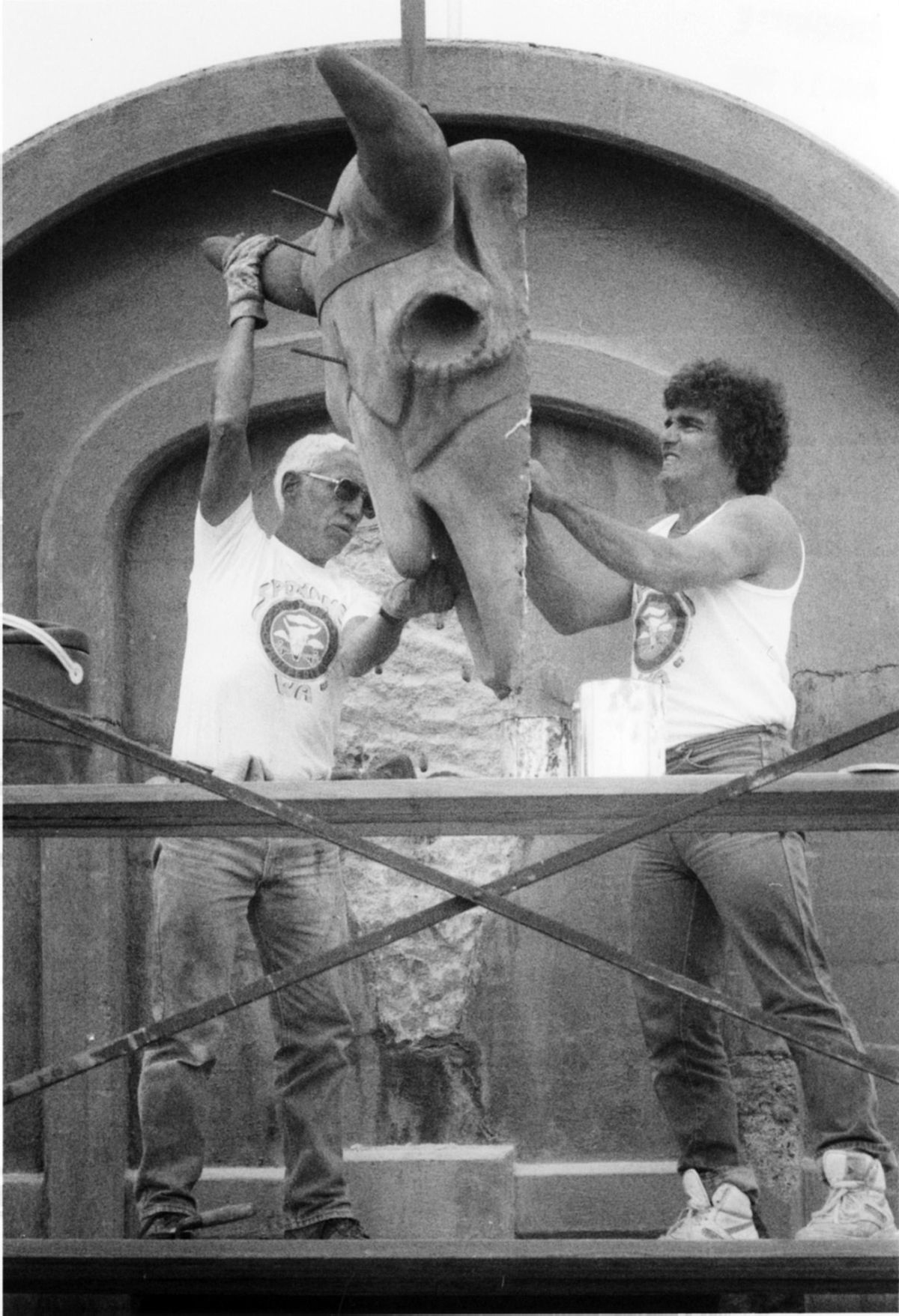Landmarks: Monroe Street bridge’s bison skull sculptures have Canada connection
City employee Jack Fruit and sculptor Don Rodgers prepare to put a buffalo skull, created by Rodgers, in place on an archway on the Monroe Street Bridge in 1989. (Shawn Jacobson / The Spokesman-Review)Buy a print of this photo
The third time a bridge was built so that travelers could cross the Spokane River at Monroe Street downtown, a local architectural firm was hired to provide ornamentation for the portion of the bridge above the deck.
That was in 1909, and the design had been envisioned to focus on the city’s pride in its pioneer heritage – including images of Native Americans and canoes, wagon trains and chain-shaped ornamentations in concrete.
Most all of that happened, except that replications of bison skulls replaced the Indians and canoes for reasons that are not known. The noted architectural firm of Cutter and Malmgren was hired for this decorative work.
Arguably Spokane’s best-known architects, Kirtland Cutter and Karl Malmgren were responsible for such structures as the Davenport Hotel, Patsy Clark Mansion, Campbell House, Corbin House, Spokane Club and more. But surely their Monroe Street designs are seen more by the public each day than any of their other creations.
They chose to place two cast concrete bison skulls (incorrectly identified by some in the early years as ox skulls) on each of the bridge’s four pedestrian pavilions that themselves are shaped like covered wagons. One skull faces the bridge deck and one is on the outer side facing either up- or downstream.
Earlier bridges at that site were less ornate.
The first Monroe Street Bridge was a somewhat flimsy wooden structure that was erected in 1889 and burned down the next year. A new steel bridge replaced it, but it vibrated so badly that by 1905 it was declared unsafe. The third bridge, begun in 1909 and completed in 1911, was designed for permanence and beauty. It is this bridge that earned a place on both the National Register (1976) and the Spokane Register (1990) of Historic Places.
However by the 1990s time and usage had again taken their toll as chunks of concrete began falling into the river more than 100 feet below. It again appeared a new bridge would be needed, and the Spokane community endorsed the idea of a replica or restoration instead of a new design. The bridge was closed from 2003 to 2005 as a look-alike replacement was erected, including replica bison skulls.
The original and second-generation Monroe Street Bridge bison skulls were modeled from a single skull found in Alberta by Spokane attorney and politician Patrick Shine, who had traveled to Drumheller, Alberta, on a coal mining expedition. His daughter Mairee (Shine) Flynn of Seattle described the venture in a Spokane Daily Chronicle story on Oct. 29, 1971. She said her father had been accompanied by rancher and banker Daniel Drumheller, for whom the Canadian city was named and had earlier served as mayor of Spokane, and Alfred Coolidge, a mining and investment financier and a banker.
Shine found the skull in his explorations, his daughter recounted, and took it to a local farmhouse a mile away; he later brought it to Spokane and eventually had it mounted on the front of the garage of his family home at 1506 W. Mission Ave. – the historic Muzzy-Shine House, which is now on the Spokane and national registers of historic places.
A newspaper story several decades after the skull was brought to Spokane noted that observers of the replica skulls on the bridge thought they were “larger than the head of any buffalo which ever roamed the western plains.” In what appears to be an attempt to dispel the notion of exaggerated size, it was remarked in the story that “doubters may see the original from which the heads were modeled … attached to Mr. Shine’s garage, in full view of the street.”
There isn’t any record of whether anyone took measurements to compare with the skulls on the bridge.
The skull from Alberta eventually was removed from the garage but what happened to it is a mystery. The current and immediate past owners of the house said they had no idea where it might be, so the life-size or larger-than-life question apparently will never be answered.

